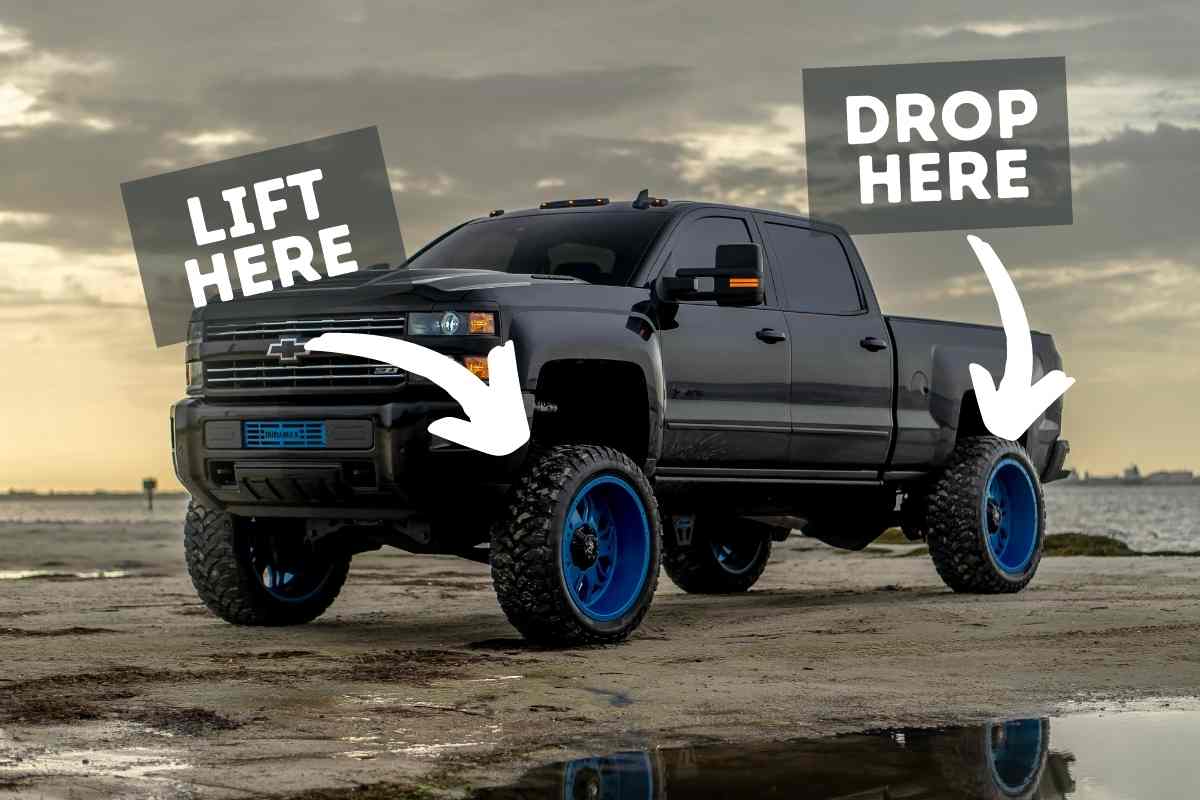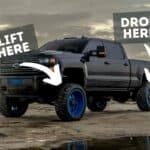What Is A Squatted Truck? “Carolina Squat”

The squatted truck modification is popular among truck owners seeking to enhance their vehicle’s appearance and performance. An integral part of this modification includes installing a lift kit, critical for those requiring increased ground clearance for off-road and rugged terrain navigation.
You can perform a body lift or a suspension lift with the latter being more effective. Lifts, such as the squat, affect the way your truck performs. You will have several advantages after a lift, but there are also a few disadvantages that you cannot ignore. So, what does a Carolina squat, or squatted truck do?
What Is A Squatted Truck?

A squatted truck is a modified truck in a way that the front is lifted more than the rear, so the rear appears sagged. The nose of your truck is raised while the bed of the truck is low.
This trend came from California before spreading to other parts of the country. The Baja Racing Circuit members modified their trucks so that they could race better in deserts where sand and hills are common. The reasoning behind the squatted truck was that when the racer hits the ground after a jump at high speed, the rear of the truck hits the ground first to avoid a crash.
The racers were able to make risky jumps and still get the truck on the path and avoid a nosedive. Most of the riders had their caps’ sun visors facing backward. Even people with squatted trucks today still drive with their hats facing backward.
The reason behind this is that after squatting a truck, the nose is raised to a point that one cannot see beyond the dash of the truck, with the hat’s brim blocking their view.
Today, squatting is not necessary as the desert races are no longer running. Lifting the front more than the rear did not serve any other purpose beyond the desert racing tracks.
Most people who squat their trucks do so to change the look of their trucks. You do not need to squat your truck unless you drive off the road a lot. I do not recommend squatting unless it is necessary for your truck’s performance.
What is the point of squatting a truck if you do not plan to race in hilly deserts?
How Much Does It Cost to Squat a Truck?
You will spend between a few hundred dollars up to $10,000 to squat your truck. The cost of squatting the truck depends on your truck size, the squat kit you choose, and whether you do it or hire a professional. Again, it also depends on how much you need to lift the truck.
Simple body lifts of about two inches will cost you only a few hundred dollars. A DIY lift kit will not cost you more than $50, but this kit will only have a few simple components. If you need a good quality kit, you must pay between $500 and $5,000.
Mechanics will charge you between $200 and $1,500, depending on the parts they have to fit and the complexity of what they have to do. If you know how to lift your truck, you can do so at home and save the money you’d otherwise spend at the mechanics.
Is Squatting Your Truck Bad?
Squatting your truck is not a bad idea if you plan to drive it at heavy high speeds off the road.
The rocks and hills will make you jump, and a squatted truck lands better than other trucks. However, it is less likely that you will be racing off-road or drive at very high speeds while there, and this makes squatting a bad idea.
When you squat your truck, you alter its geometry and its performance. If you only use your truck on-road, there are things that will not go right. Squatting is not illegal in the U.S., but it might be in the next few years.
There are so many people who consider the modification unsafe, and they rally to have it illegalized. People have filed petitions showing the dangers that squatted trucks pose and these petitions could bear fruits soon.
For instance, the practice is seen and portrayed as obnoxious in California. People who are against it are very vocal on social media and see it as unsafe for the general public. These people sensitize people on the dangers of a squatted truck and ask them to avoid it.
Which are some of the problems that come with squatting a truck?
Poor Steering and Braking Control
When you lift a truck’s front more than the rear, you offset the balance of that truck. After the lift, you will need to tilt the seat so that it is slightly backside. The change in driver’s sitting arrangement affects braking and steering.
The driver has a less ergonomic control of the steering wheel and the brakes. Worse still, the driver doesn’t have a clear view of oncoming traffic as they have to look over the steering wheel.
Headlight Aims Up
If you do not modify the headlights of the truck after the lift, the headlights will aim upwards. The elevation goes with the headlights; instead of aiming at the road, the headlights will fall into the eyes of oncoming drivers.
Oncoming cars’ drivers might lose visibility, and this is one way accidents occur. This shows that squatting is not only dangerous to the driver of the truck, but also to other motorists.
Most motorists will change the factory lights for more powerful lights. If you do that with a squatted truck, you will minimize visibility for other drivers on the road even more. Furthermore, the upward-pointed headlights do not even help you as you do not see the road and oncoming traffic.
Drivers traveling the same direction as the squatted truck are also not safe as the beam of light falls on their rearview mirror. This causes them stress and obstructs the view of what is behind them. Consequently, this can result in an accident.
Rough Drive
When you lift the front of your truck more than the rear, you affect the truck’s suspension system. The suspension system and associated parts such as shocks will wear faster. This makes your ride uncomfortably rough.
It is not uncommon for drivers in such trucks to face high jerks. If you tow or haul any load, the truck will be even more uncomfortable.
Trailer Sway
Most truck automakers engineer the rear to be more raised than the front. This way, when the truck is under load, the front will raise a little to create a balance. A squatted truck already looks like it is already heavily loaded.
If you drive a squatted truck at high speeds when under a load, there is a chance that it will sway. You can minimize swaying by driving slow and avoiding bumps and potholes.
Body Roll
Body roll is common with squatted trucks. This occurs when different parts of your truck malfunction. In a squatted truck, the suspension system and shocks will malfunction, resulting in body roll. When squatting your vehicle, you will modify the wheels and the shocks, and this minimizes your truck’s ability to handle body roll.
There is a high chance that the truck will sway from its usual path when you take on sharp corners and turns.
Reduced Towing Capability
You cannot tow much with a squatted vehicle. Trucks sag a little when under load. Squatted trucks look like they are already sagged.
Unless you drive off the road, and you need a squatted truck, there is no use spending your money to squat a truck. You will spend thousands of dollars lifting a truck, but then it puts you in danger.
How Do You Squat a Truck?
There are several squat kits to choose from when you need to lift the front of your truck. These kits are available for different truck makes and models. The increasing popularity of squat kits among youngsters makes them more available.
You can lift the front of the truck to between two and ten inches. However, you may have to do other modifications and even remove some parts.
You can achieve a squat through a body lift kit. These are simple to install, and they do not affect the performance of your truck. Get a kit for your truck’s make and model and install it on the front end of your truck.
You can also do a suspension lift. This includes elevating the ball joints of the truck’s suspension system by adjusting the torsion bar’s height. A suspension lift is more labor intensive and requires more parts than a body lift.
Besides lifting the truck’s front end, you can lower the rear. This is ideal when you need an extreme squatted look. To do that, lift the front and then remove the rear blocks.
Better yet, drop shackles springs can help lower the rear further by two inches. Instead of the ordinary lift kit, you can go for a long travel kit. This will cost you more money but delivers better performance than the standard lift kit.
Why is the Carolina Squat Popular?
There are trucks everywhere with a sagged rear. It makes one wonder, are squatted trucks illegal?
Yes, they are legal even with all the danger they pose. These trucks became popular after a number of people posted their squatted trucks on social media. Squatted trucks became popular on Instagram before they gained popularity elsewhere, and this is where most people picked up the trend.
If you search terms such as truck lean, truck squat, Carolina lean, or squatted trucks on Instagram, you will see several pages dedicated to these trucks. The pages have thousands of followers, most of who are from Georgia, Louisiana, North, and South Carolina, and California.
It is in these states where squatted trucks are common. Although social media made the trend popular, manufacturers have also taken it up and are producing squat kits that enable the modification.
Squatting is common on front suspension trucks.
Should You Squat Your Truck?
There are trucks that take the modifications well and others whose performance and look are totally damaged.
When you deviate from factory parameters and alter the geometry of a truck, the truck will not perform as the automaker intended. It is best if you do not squat your truck unless it is absolutely necessary.
Absolute necessity, in this case, means you will be racing in hilly deserts, and you need to avoid a nosedive. If that is not the case, a squat doesn’t serve any functional purpose, and you should avoid it.
By squatting a truck, you affect the way it drives and the way it tows. After the squat, you need to perform other modifications such as on the computer so that the odometer and speedometer read right.
Again, if you have never lifted a truck before, avoid DIY lifts as you may damage some components of your truck while at it.
Related Lifted Truck Articles
Closing Thoughts
I see squatted trucks every day. The look and style doesn’t appeal to me as I love my truck balanced for better handling. Since squatting has no functional benefit, I do not see why I can squat my truck.
To the youngsters, the trucks look great and they are ideal for garnering Instagram followers, but what are followers when your truck is not safe when you drive it.
As a driver, your safety and that of other drivers on the road should be your priority, and this means you avoiding a squatted truck.
If you still want to have squatted truck look and performance, you can go for air rides or suspension stabilizers. These are more expensive options but offer adjustability and are safer than squatting.
A truck is engineered to haul and tow load; if a modification doesn’t allow that, you have the wrong modification. Your truck should also go off the road; any modification you take on should allow that and not hinder it.
Because squatting increases the chances of a body roll, it makes your truck less of a workhorse and less of an off-roader.
Squatted Truck: What It Is and Why It’s Popular
Frequently Asked Questions
Are squatted trucks illegal in Alabama?

In Alabama, squatted trucks are not specifically illegal. However, any vehicle modification that impairs the driver’s vision or control over the vehicle is prohibited. So, if the squatting modification causes the driver to lose control or impairs their vision, it could result in a ticket or fine.
Are squatted trucks illegal in Texas?

In Texas, squatted trucks are not illegal as long as they meet certain requirements. According to Texas law, the bottom of the vehicle’s frame cannot be lower than the lowest point of the wheel rims. Additionally, the headlights must be no higher than 54 inches from the ground.
What is the squatted truck law in South Carolina?

In South Carolina, squatted trucks are not specifically illegal. However, any vehicle modification that impairs the driver’s vision or control over the vehicle is prohibited. So, if the squatting modification causes the driver to lose control or impairs their vision, it could result in a ticket or fine.
Are squatted trucks illegal in Georgia?
In Georgia, squatted trucks are not specifically illegal. However, any vehicle modification that impairs the driver’s vision or control over the vehicle is prohibited. So, if the squatting modification causes the driver to lose control or impairs their vision, it could result in a ticket or fine.
Why were squatted trucks banned?
Squatted trucks were banned in certain states due to safety concerns. The squatting modification can cause the front of the truck to be higher than the back, which can impair the driver’s vision and control over the vehicle. Additionally, the modification can cause the truck to be more prone to rollovers and accidents.
What is the new law for Carolina squat trucks?
In North Carolina, a new law was passed in 2021 that prohibits vehicles from having a suspension height modification of more than three inches. This law was put in place to address safety concerns related to squatted trucks, which can cause the front of the vehicle to be higher than the back, impairing the driver’s vision and control over the vehicle.

Jacked up trucks just look stupid, they are unsafe, unstable and dangerous in an accident. Jacked up trucks are just little guys wannabe big truckers but have no talent for the big trucks. As far as this “squatting” stuff, all the info here is fake, excuses for looking stupid. The real squat came from the 50s in drag racing trying to put as much weight on the rear wheels without adding any weight to the car. FACT.